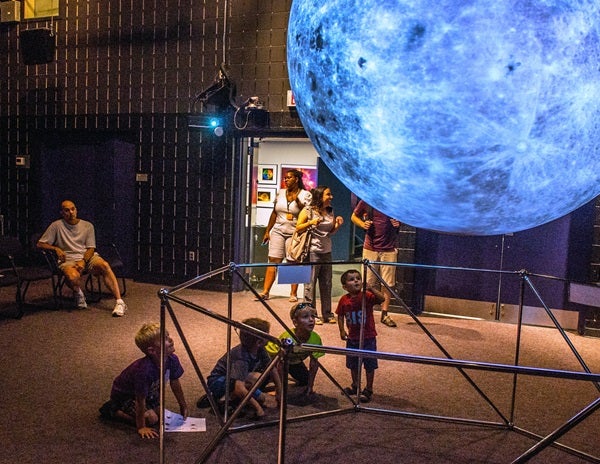• The Moon is one-quarter the diameter of Earth and roughly a quarter million miles (400,000 kilometers) away. If Earth were shrunk to the size of a basketball, on average, the Moon would be the size of a tennis ball about 25 feet (7.5 meters) away.

Bringing the universe to your door. We’re excited to announce Astronomy magazine’s new Space and Beyond subscription box – a quarterly adventure, curated with an astronomy-themed collection in every box. Learn More >>.
• Lunar daytime (sunrise to sunset) lasts about 14¾ days. Same with a lunar night. For this reason, and because the Moon has no atmosphere, the sunlit half of the Moon reaches a temperature of around 250 degrees Fahrenheit (120 degrees Celsius), while the night side is a chilly minus 290 F (minus 180 C). That’s a day-night difference of 540 F (300 C).
• The Moon’s gravity is about one-sixth that of Earth’s. A world-class weightlifter capable of lifting 450 pounds (200 kilograms) on Earth could hoist 2,700 pounds (1,225 kg) on the Moon. A golfer who can smack a 350-yard drive would launch a golf ball more than 1.2 miles (1.9 km) at the Sea of Tranquility Country Club.
• The lunar maria really are seas — seas of lava. Billions of years ago, volcanic activity allowed molten material from the Moon’s interior to flow to the surface and fill in lowland regions. These lava oceans eventually cooled to form dark basaltic plains. Little of the Moon’s surface has changed since. For that reason, the naked-eye Moon looks essentially the same to us as it did to the dinosaurs — albeit a little smaller.
• That’s because the Moon is slowly ditching Earth. Each year, the Moon drifts about 1.5 inches (3.8 centimeters) away from us. About 170 million years ago, during the middle of the Jurassic Period, the Moon was some 4,000 miles (6,400 km) closer to Earth. But you wouldn’t notice the difference.
• From Apollo landers to Moon buggies to unmanned lunar probes, humans have left about 200 tons of material on the Moon. But they’ve also brought pieces of the Moon back to Earth. From 1969 to 1972, Apollo astronauts collected 842 pounds (382 kg) of Moon rocks and soil for return to Earth.
• The footprints left behind by the Apollo 11 astronauts are still there after a half century. Because the Moon lacks an atmosphere, there is no wind or rain to erase them. Micrometeorites do slowly erode the surface; however, unless a significant meteorite obliterates the landing site with a direct hit, the footprints will remain for millennia to come.
• The Moon smells! But it doesn’t smell like the fabled green cheese. Apollo 11 astronaut Buzz Aldrin noted that fresh regolith (Moon dust and dirt) smelled “like burnt charcoal or similar to the ashes that are in a fireplace, especially if you sprinkle a little water on them.” Astronaut and geologist Harrison Schmitt of Apollo 17 concurred, noting that the lunar soil left the cabin air smelling like spent gunpowder.
• A telescopic view of the Moon can be an life-altering sight to young eyes. So here’s a motivational fact to share with any school-aged children: Their next close-up view of the Moon could be from its surface. By studying hard, they might be able to join a scientific team stationed at a future Moon base!
The bad news: Manned exploration of the Moon has been dead for decades. The Apollo era ended with the Apollo 17 lunar lift-off on December 14, 1972. The good news: We’re going back soon. This March, Vice President Mike Pence announced Americans will aim to return to the lunar surface by 2024. Stay tuned.
Questions, comments, or suggestions? Email me gchaple@hotmail.com. Next month: Watch Mercury cross the Sun! Clear Skies!










